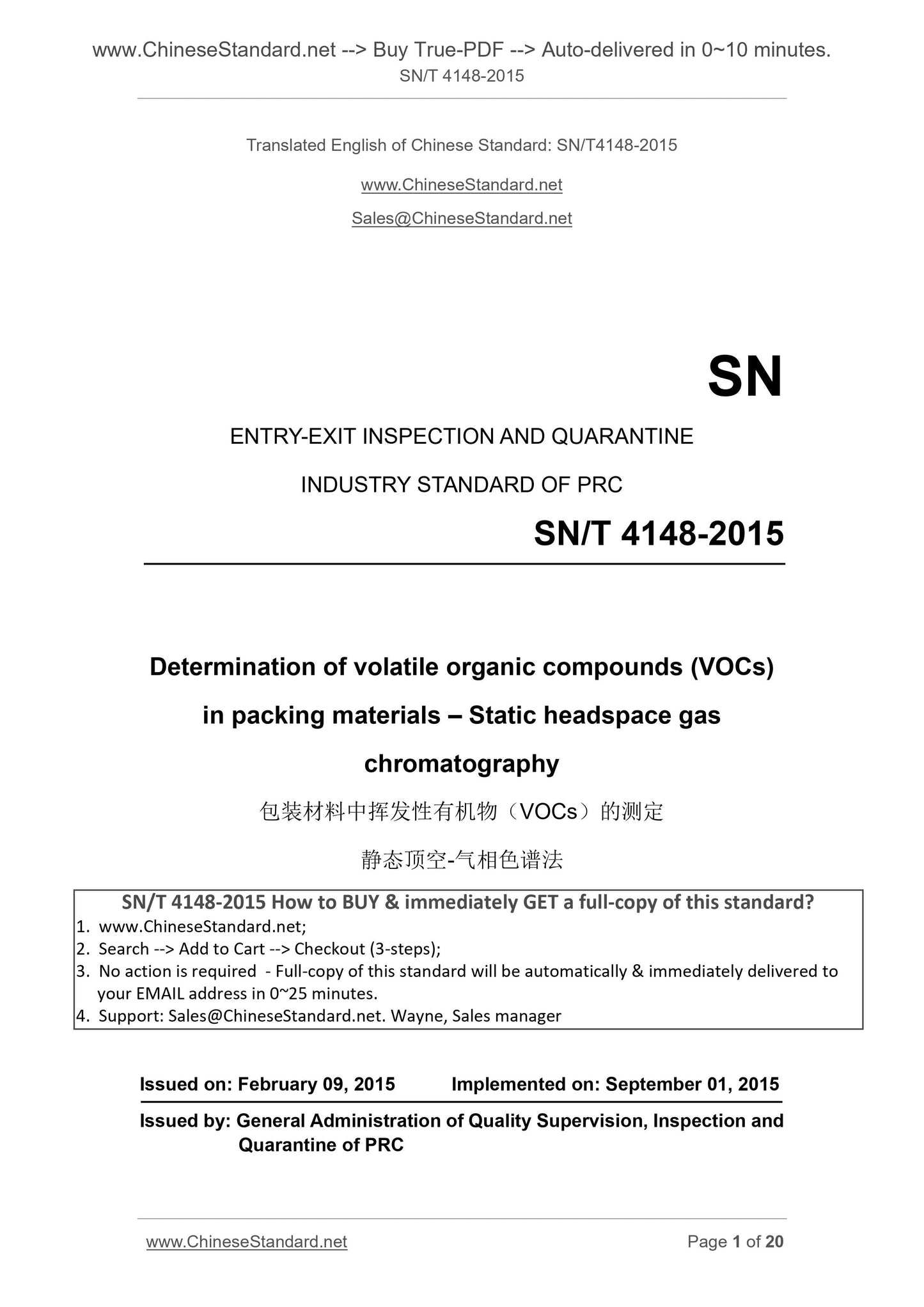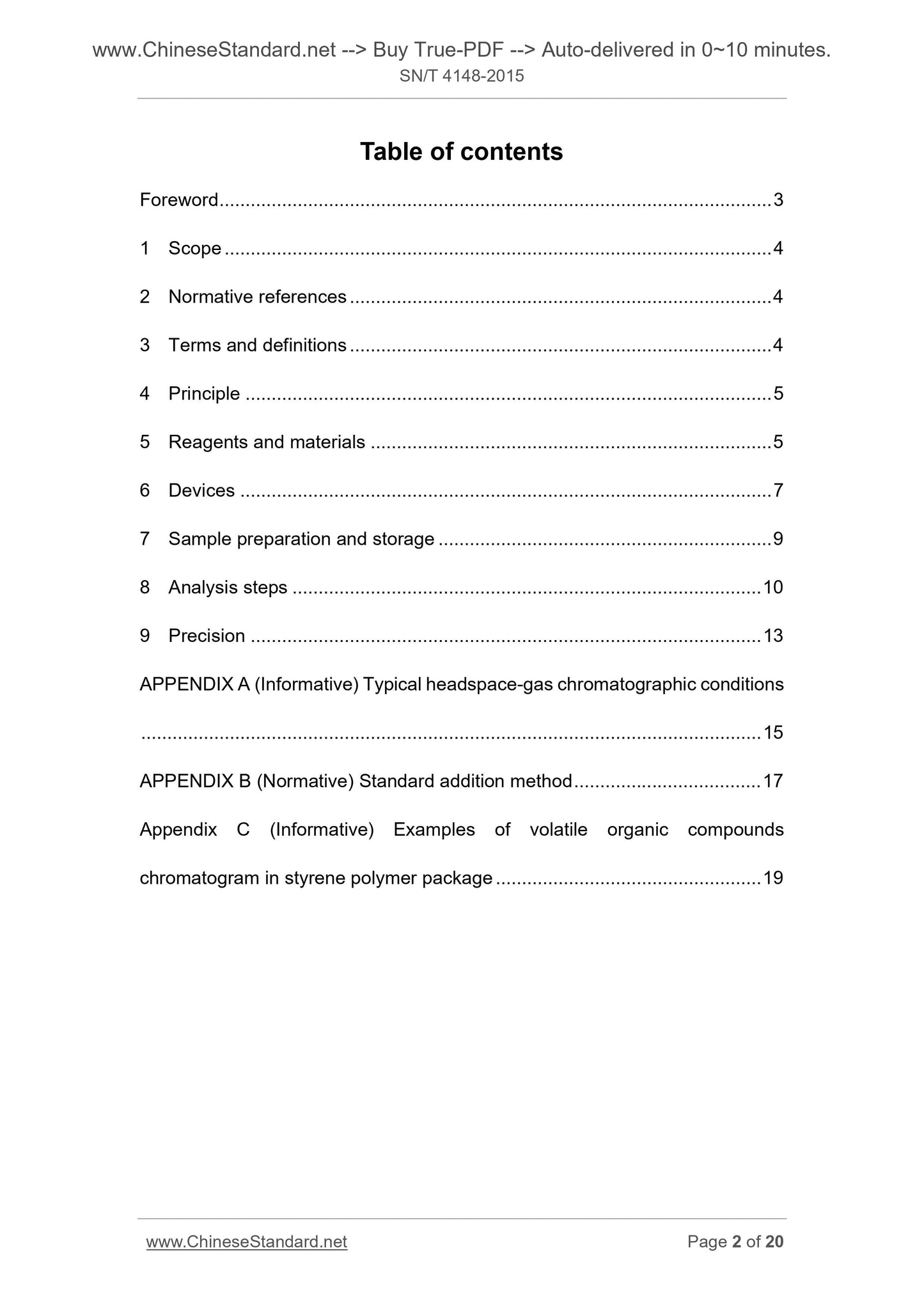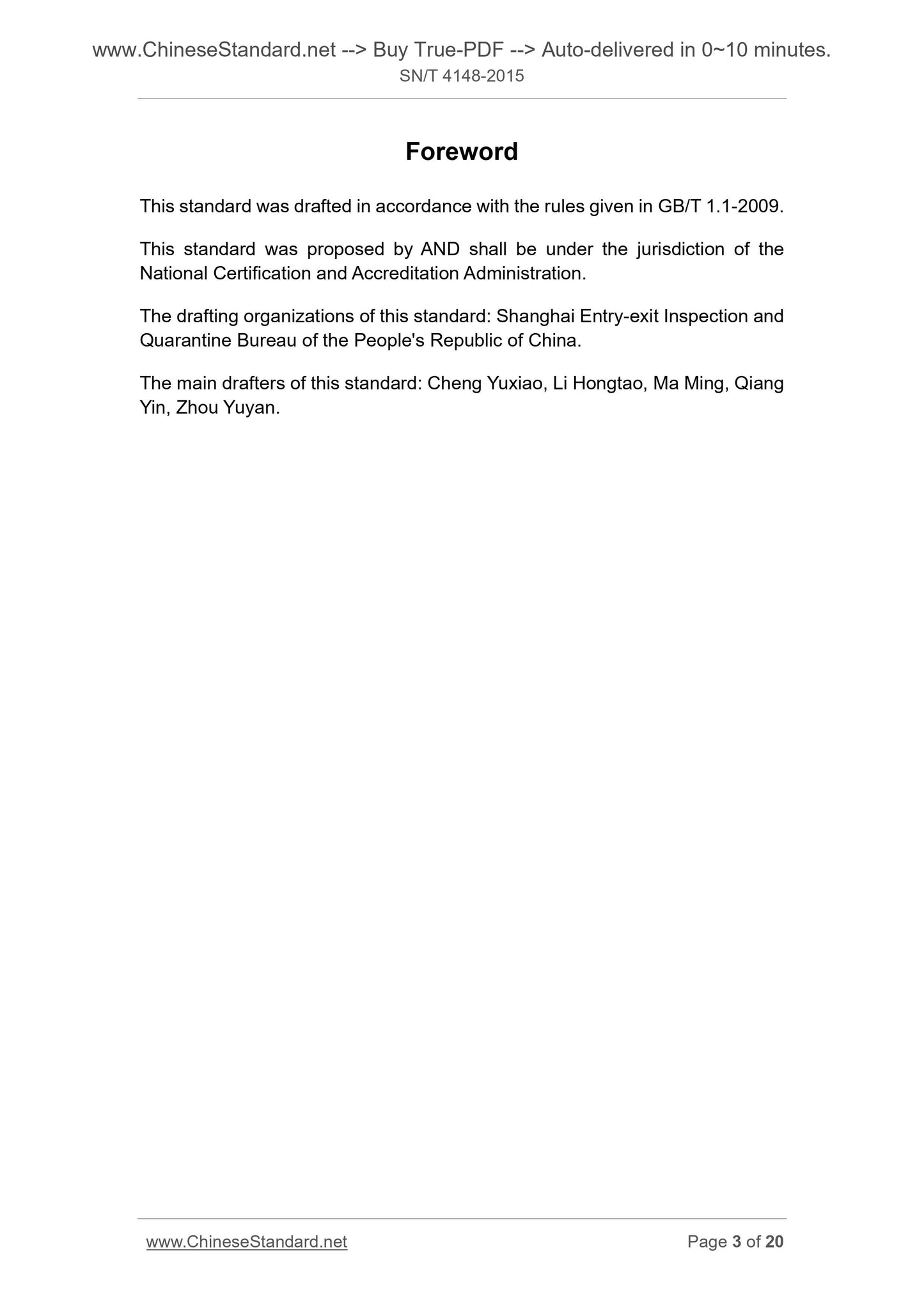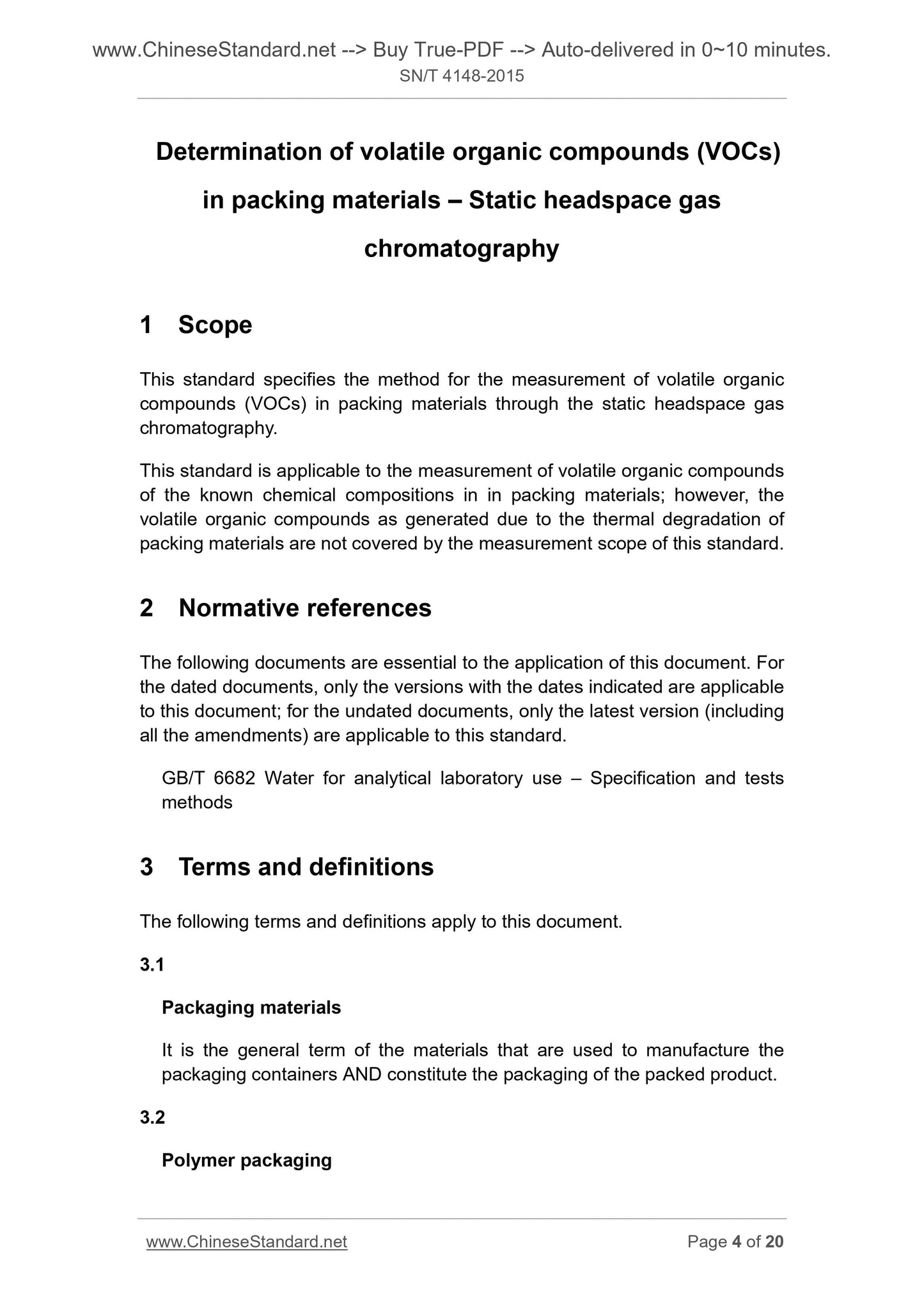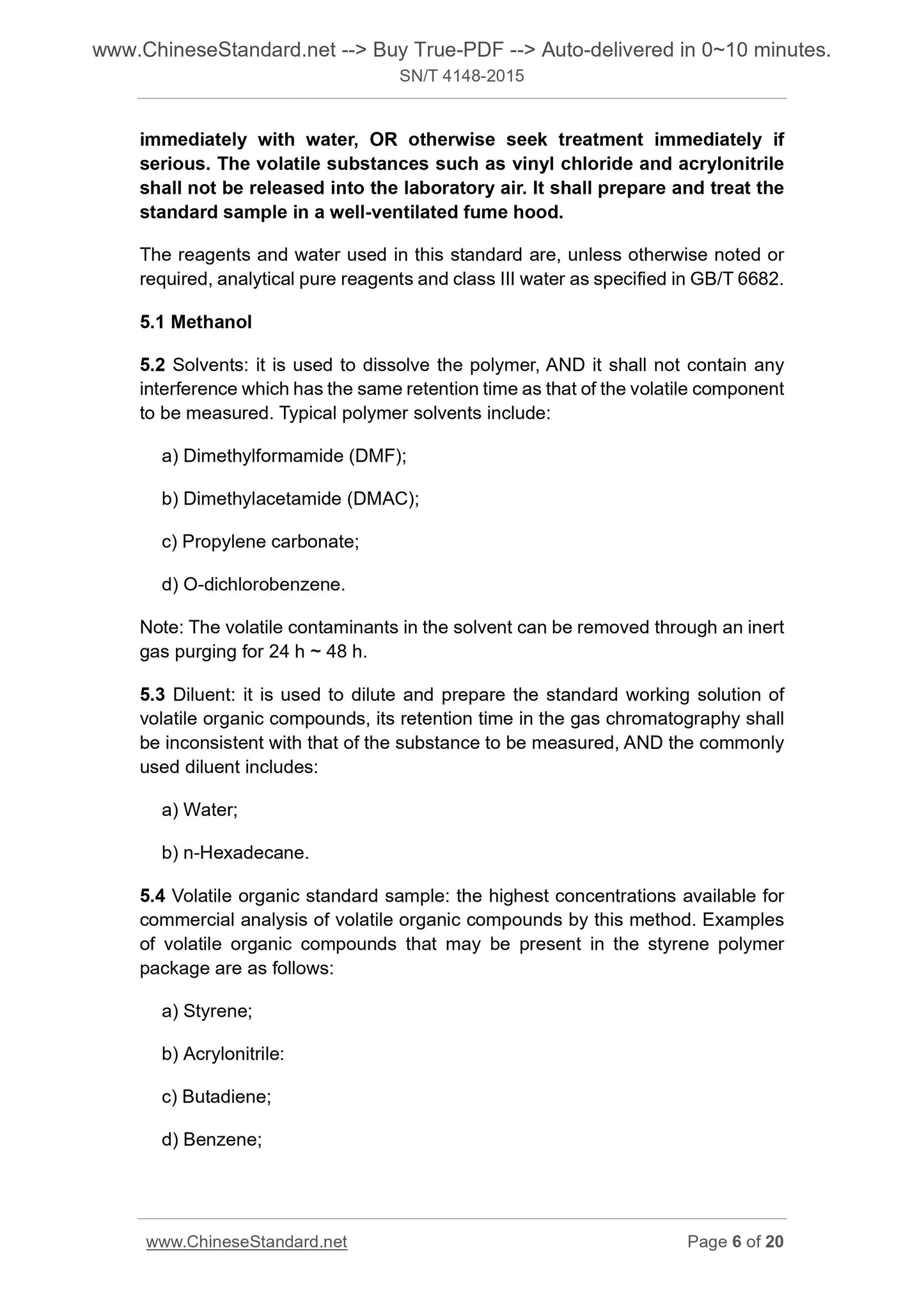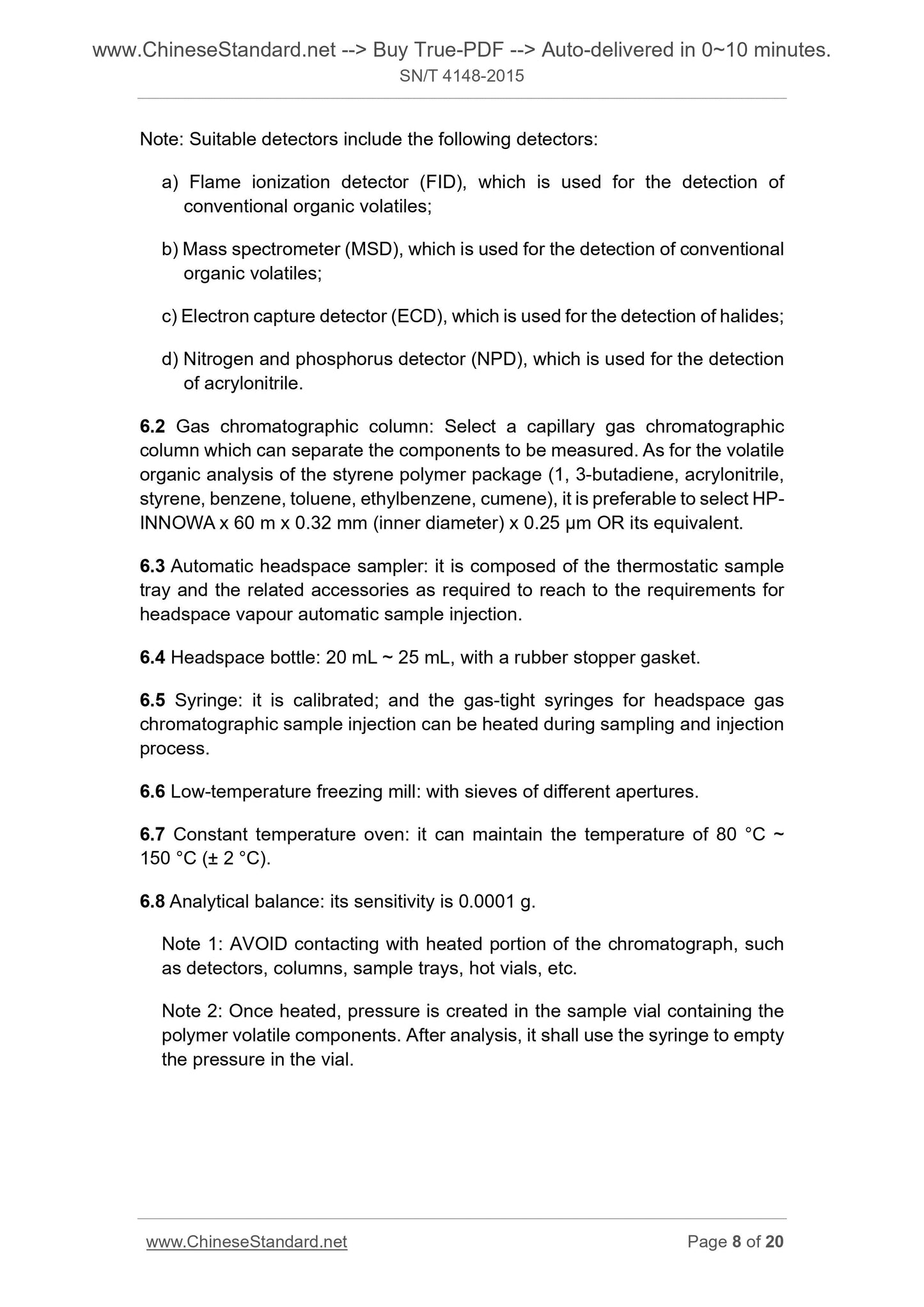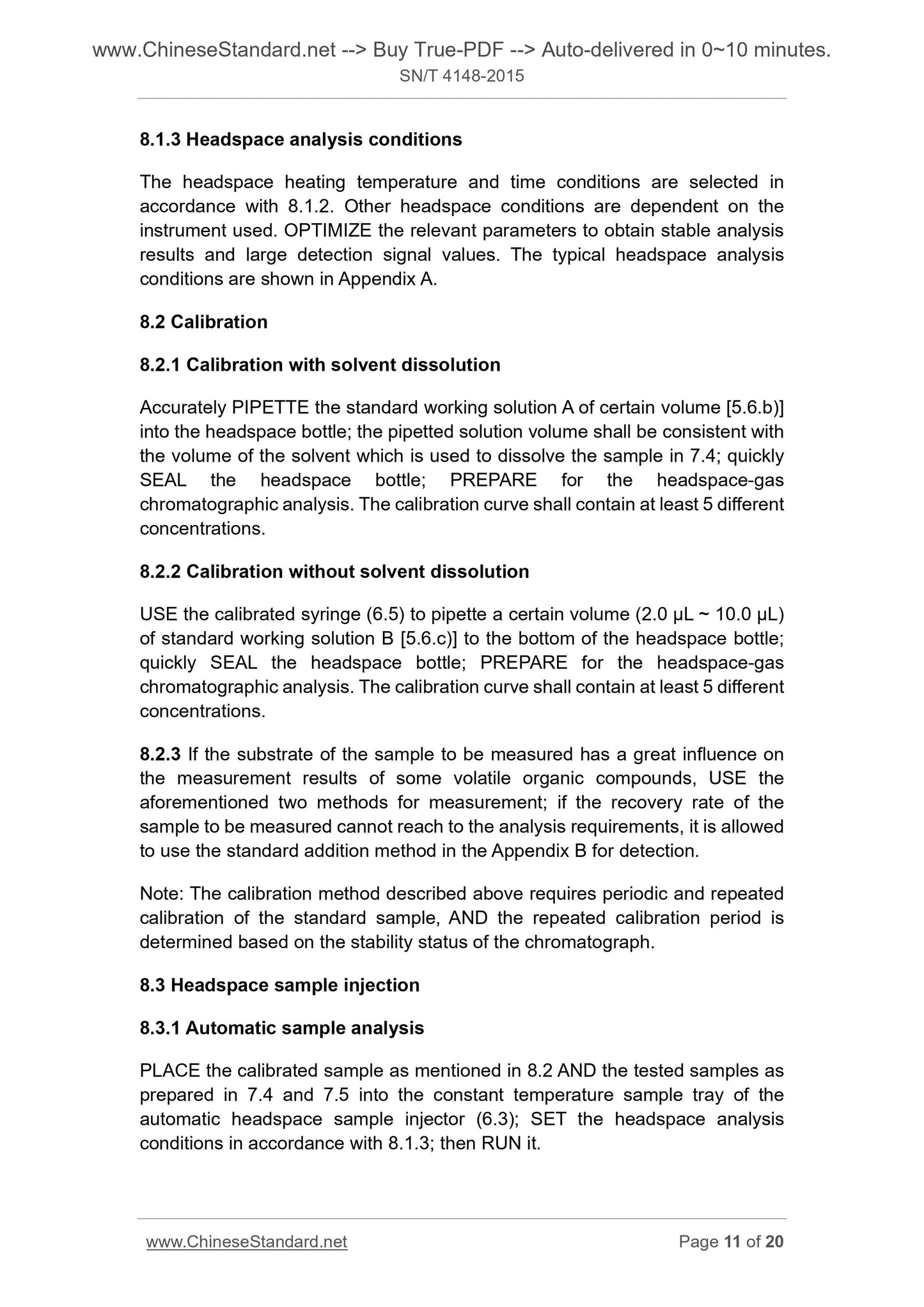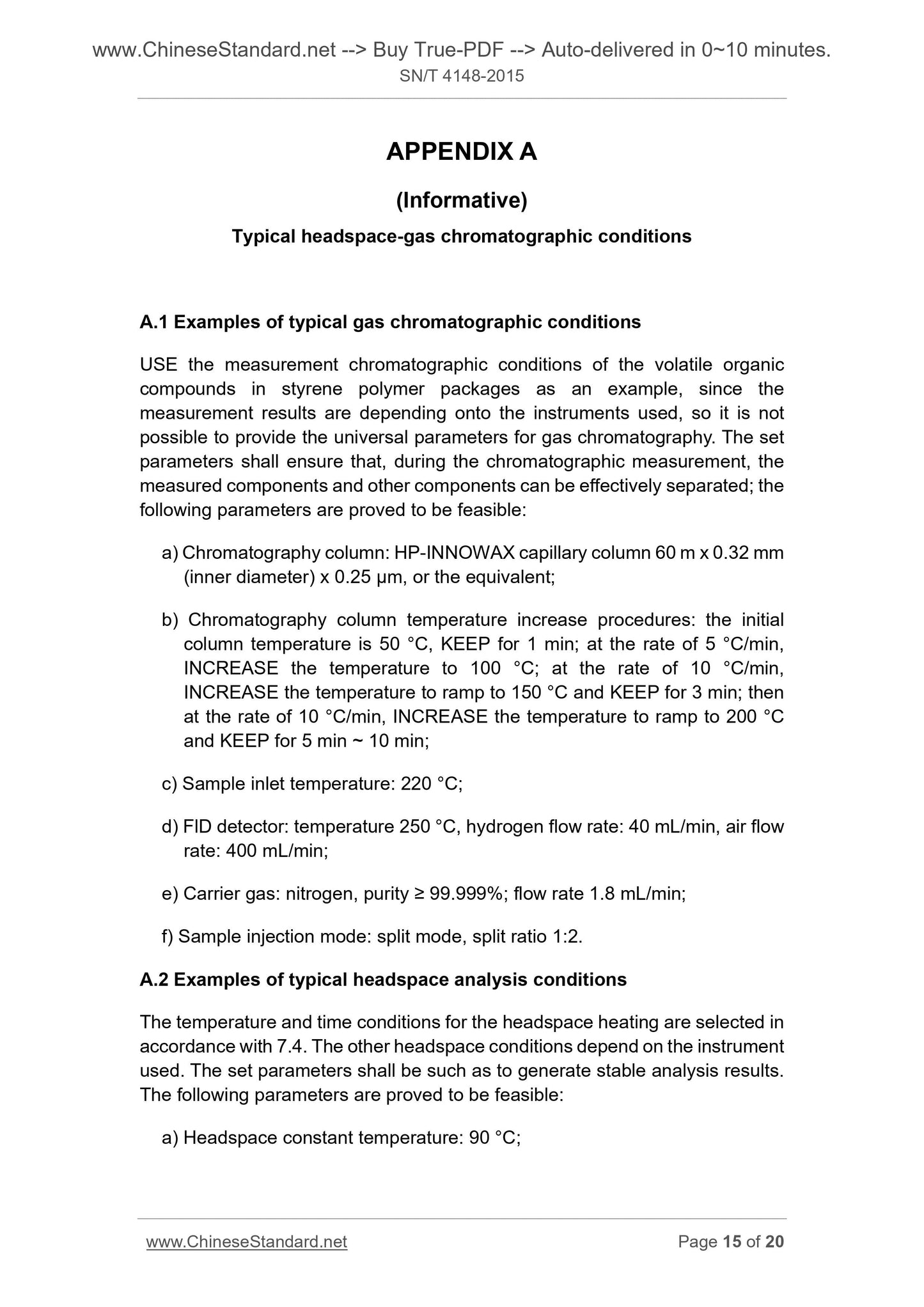PayPal, credit cards. Download editable-PDF & invoice in 1 second!
SN/T 4148-2015 English PDF (SNT4148-2015)
SN/T 4148-2015 English PDF (SNT4148-2015)
Precio habitual
$145.00 USD
Precio habitual
Precio de oferta
$145.00 USD
Precio unitario
/
por
Los gastos de envío se calculan en la pantalla de pago.
No se pudo cargar la disponibilidad de retiro
Delivery: 3 seconds. Download true-PDF + Invoice.
Get QUOTATION in 1-minute: Click SN/T 4148-2015
Historical versions: SN/T 4148-2015
Preview True-PDF (Reload/Scroll if blank)
SN/T 4148-2015: Determinaiton of volatile organic compounds(VOCs) in packing materials. Static headspace gas chromatography
SN/T 4148-2015
SN
ENTRY-EXIT INSPECTION AND QUARANTINE
INDUSTRY STANDARD OF PRC
Determination of volatile organic compounds (VOCs)
in packing materials – Static headspace gas
chromatography
ISSUED ON. FEBRUARY 09, 2015
IMPLEMENTED ON. SEPTEMBER 01, 2015
Issued by. General Administration of Quality Supervision, Inspection and
Quarantine of PRC
Table of contents
Foreword ... 3
1 Scope ... 4
2 Normative references ... 4
3 Terms and definitions ... 4
4 Principle ... 5
5 Reagents and materials ... 5
6 Devices ... 7
7 Sample preparation and storage ... 9
8 Analysis steps ... 10
9 Precision ... 13
APPENDIX A (Informative) Typical headspace-gas chromatographic conditions
... 15
APPENDIX B (Normative) Standard addition method ... 17
Appendix C (Informative) Examples of volatile organic compounds
chromatogram in styrene polymer package ... 19
Foreword
This standard was drafted in accordance with the rules given in GB/T 1.1-2009.
This standard was proposed by AND shall be under the jurisdiction of the
National Certification and Accreditation Administration.
The drafting organizations of this standard. Shanghai Entry-exit Inspection and
Quarantine Bureau of the People's Republic of China.
The main drafters of this standard. Cheng Yuxiao, Li Hongtao, Ma Ming, Qiang
Yin, Zhou Yuyan.
Determination of volatile organic compounds (VOCs)
in packing materials – Static headspace gas
chromatography
1 Scope
This standard specifies the method for the measurement of volatile organic
compounds (VOCs) in packing materials through the static headspace gas
chromatography.
This standard is applicable to the measurement of volatile organic compounds
of the known chemical compositions in in packing materials; however, the
volatile organic compounds as generated due to the thermal degradation of
packing materials are not covered by the measurement scope of this standard.
2 Normative references
The following documents are essential to the application of this document. For
the dated documents, only the versions with the dates indicated are applicable
to this document; for the undated documents, only the latest version (including
all the amendments) are applicable to this standard.
GB/T 6682 Water for analytical laboratory use – Specification and tests
methods
3 Terms and definitions
The following terms and definitions apply to this document.
3.1
Packaging materials
It is the general term of the materials that are used to manufacture the
packaging containers AND constitute the packaging of the packed product.
3.2
Polymer packaging
immediately with water, OR otherwise seek treatment immediately if
serious. The volatile substances such as vinyl chloride and acrylonitrile
shall not be released into the laboratory air. It shall prepare and treat the
standard sample in a well-ventilated fume hood.
The reagents and water used in this standard are, unless otherwise noted or
required, analytical pure reagents and class III water as specified in GB/T 6682.
5.1 Methanol
5.2 Solvents. it is used to dissolve the polymer, AND it shall not contain any
interference which has the same retention time as that of the volatile component
to be measured. Typical polymer solvents include.
a) Dimethylformamide (DMF);
b) Dimethylacetamide (DMAC);
c) Propylene carbonate;
d) O-dichlorobenzene.
Note. The volatile contaminants in the solvent can be removed through an inert
gas purging for 24 h ~ 48 h.
5.3 Diluent. it is used to dilute and prepare the standard working solution of
volatile organic compounds, its retention time in the gas chromatography shall
be inconsistent with that of the substance to be measured, AND the commonly
used diluent includes.
a) Water;
b) n-Hexadecane.
5.4 Volatile organic standard sample. the highest concentrations available for
commercial analysis of volatile organic compounds by this method. Examples
of volatile organic compounds that may be present in the styrene polymer
package are as follows.
a) Styrene;
b) Acrylonitrile.
c) Butadiene;
d) Benzene;
Note. Suitable detectors include the following detectors.
a) Flame ionization detector (FID), which is used for the detection of
conventional organic volatiles;
b) Mass spectrometer (MSD), which is used for the detection of conventional
organic volatiles;
c) Electron capture detector (ECD), which is used for the detection of halides;
d) Nitrogen and phosphorus detector (NPD), which is used for the detection
of acrylonitrile.
6.2 Gas chromatographic column. Select a capillary gas chromatographic
column which can separate the components to be measured. As for the volatile
organic analysis of the styrene polymer package (1, 3-butadiene, acrylonitrile,
styrene, benzene, toluene, ethylbenzene, cumene), it is preferable to select HP-
INNOWA x 60 m x 0.32 mm (inner diameter) x 0.25 μm OR its equivalent.
6.3 Automatic headspace sampler. it is composed of the thermostatic sample
tray and the related accessories as required to reach to the requirements for
headspace vapour automatic sample injection.
6.4 Headspace bottle. 20 mL ~ 25 mL, with a rubber stopper gasket.
6.5 Syringe. it is calibrated; and the gas-tight syringes for headspace gas
chromatographic sample injection can be heated during sampling and injection
process.
6.6 Low-temperature freezing mill. with sieves of different apertures.
6.7 Constant temperature oven. it can maintain the temperature of 80 °C ~
150 °C (± 2 °C).
6.8 Analytical balance. its sensitivity is 0.0001 g.
Note 1. AVOID contacting with heated portion of the chromatograph, such
as detectors, columns, sample trays, hot vials, etc.
Note 2. Once heated, pressure is created in the sample vial containing the
polymer volatile components. After analysis, it shall use the syringe to empty
the pressure in the vial.
8.1.3 Headspace analysis conditions
The headspace heating temperature and time conditions are selected in
accordance with 8.1.2. Other headspace conditions are dependent on the
instrument used. OPTIMIZE the relevant parameters to obtain stable analysis
results and large detection signal values. The typical headspace analysis
conditions are shown in Appendix A.
8.2 Calibration
8.2.1 Calibration with solvent dissolution
Accurately PIPETTE the standard working solution A of certain volume [5.6.b)]
into the headspace bottle; the pipetted solution volume shall be consistent with
the volume of the solvent which is used to dissolve the sample in 7.4; quickly
SEAL the headspace bottle; PREPARE for the headspace-gas
chromatographic analysis. The calibration curve shall contain at least 5 different
concentrations.
8.2.2 Calibration without solvent dissolution
USE the calibrated syringe (6.5) to pipette a certain volume (2.0 µL ~ 10.0 µL)
of standard working solution B [5.6.c)] to the bottom of the headspace bottle;
quickly SEAL the headspace bottle; PREPARE for the headspace-gas
chromatographic analysis. The calibration curve shall contain at least 5 different
concentrations.
8.2.3 If the substrate of the sample to be measured has a great influence on
the measurement results of some volatile organic compounds, USE the
aforementioned two methods for measurement; if the recovery rate of the
sample to be measured cannot reach to the analysis requirements, it is allowed
to use the standard addition method in t...
Get QUOTATION in 1-minute: Click SN/T 4148-2015
Historical versions: SN/T 4148-2015
Preview True-PDF (Reload/Scroll if blank)
SN/T 4148-2015: Determinaiton of volatile organic compounds(VOCs) in packing materials. Static headspace gas chromatography
SN/T 4148-2015
SN
ENTRY-EXIT INSPECTION AND QUARANTINE
INDUSTRY STANDARD OF PRC
Determination of volatile organic compounds (VOCs)
in packing materials – Static headspace gas
chromatography
ISSUED ON. FEBRUARY 09, 2015
IMPLEMENTED ON. SEPTEMBER 01, 2015
Issued by. General Administration of Quality Supervision, Inspection and
Quarantine of PRC
Table of contents
Foreword ... 3
1 Scope ... 4
2 Normative references ... 4
3 Terms and definitions ... 4
4 Principle ... 5
5 Reagents and materials ... 5
6 Devices ... 7
7 Sample preparation and storage ... 9
8 Analysis steps ... 10
9 Precision ... 13
APPENDIX A (Informative) Typical headspace-gas chromatographic conditions
... 15
APPENDIX B (Normative) Standard addition method ... 17
Appendix C (Informative) Examples of volatile organic compounds
chromatogram in styrene polymer package ... 19
Foreword
This standard was drafted in accordance with the rules given in GB/T 1.1-2009.
This standard was proposed by AND shall be under the jurisdiction of the
National Certification and Accreditation Administration.
The drafting organizations of this standard. Shanghai Entry-exit Inspection and
Quarantine Bureau of the People's Republic of China.
The main drafters of this standard. Cheng Yuxiao, Li Hongtao, Ma Ming, Qiang
Yin, Zhou Yuyan.
Determination of volatile organic compounds (VOCs)
in packing materials – Static headspace gas
chromatography
1 Scope
This standard specifies the method for the measurement of volatile organic
compounds (VOCs) in packing materials through the static headspace gas
chromatography.
This standard is applicable to the measurement of volatile organic compounds
of the known chemical compositions in in packing materials; however, the
volatile organic compounds as generated due to the thermal degradation of
packing materials are not covered by the measurement scope of this standard.
2 Normative references
The following documents are essential to the application of this document. For
the dated documents, only the versions with the dates indicated are applicable
to this document; for the undated documents, only the latest version (including
all the amendments) are applicable to this standard.
GB/T 6682 Water for analytical laboratory use – Specification and tests
methods
3 Terms and definitions
The following terms and definitions apply to this document.
3.1
Packaging materials
It is the general term of the materials that are used to manufacture the
packaging containers AND constitute the packaging of the packed product.
3.2
Polymer packaging
immediately with water, OR otherwise seek treatment immediately if
serious. The volatile substances such as vinyl chloride and acrylonitrile
shall not be released into the laboratory air. It shall prepare and treat the
standard sample in a well-ventilated fume hood.
The reagents and water used in this standard are, unless otherwise noted or
required, analytical pure reagents and class III water as specified in GB/T 6682.
5.1 Methanol
5.2 Solvents. it is used to dissolve the polymer, AND it shall not contain any
interference which has the same retention time as that of the volatile component
to be measured. Typical polymer solvents include.
a) Dimethylformamide (DMF);
b) Dimethylacetamide (DMAC);
c) Propylene carbonate;
d) O-dichlorobenzene.
Note. The volatile contaminants in the solvent can be removed through an inert
gas purging for 24 h ~ 48 h.
5.3 Diluent. it is used to dilute and prepare the standard working solution of
volatile organic compounds, its retention time in the gas chromatography shall
be inconsistent with that of the substance to be measured, AND the commonly
used diluent includes.
a) Water;
b) n-Hexadecane.
5.4 Volatile organic standard sample. the highest concentrations available for
commercial analysis of volatile organic compounds by this method. Examples
of volatile organic compounds that may be present in the styrene polymer
package are as follows.
a) Styrene;
b) Acrylonitrile.
c) Butadiene;
d) Benzene;
Note. Suitable detectors include the following detectors.
a) Flame ionization detector (FID), which is used for the detection of
conventional organic volatiles;
b) Mass spectrometer (MSD), which is used for the detection of conventional
organic volatiles;
c) Electron capture detector (ECD), which is used for the detection of halides;
d) Nitrogen and phosphorus detector (NPD), which is used for the detection
of acrylonitrile.
6.2 Gas chromatographic column. Select a capillary gas chromatographic
column which can separate the components to be measured. As for the volatile
organic analysis of the styrene polymer package (1, 3-butadiene, acrylonitrile,
styrene, benzene, toluene, ethylbenzene, cumene), it is preferable to select HP-
INNOWA x 60 m x 0.32 mm (inner diameter) x 0.25 μm OR its equivalent.
6.3 Automatic headspace sampler. it is composed of the thermostatic sample
tray and the related accessories as required to reach to the requirements for
headspace vapour automatic sample injection.
6.4 Headspace bottle. 20 mL ~ 25 mL, with a rubber stopper gasket.
6.5 Syringe. it is calibrated; and the gas-tight syringes for headspace gas
chromatographic sample injection can be heated during sampling and injection
process.
6.6 Low-temperature freezing mill. with sieves of different apertures.
6.7 Constant temperature oven. it can maintain the temperature of 80 °C ~
150 °C (± 2 °C).
6.8 Analytical balance. its sensitivity is 0.0001 g.
Note 1. AVOID contacting with heated portion of the chromatograph, such
as detectors, columns, sample trays, hot vials, etc.
Note 2. Once heated, pressure is created in the sample vial containing the
polymer volatile components. After analysis, it shall use the syringe to empty
the pressure in the vial.
8.1.3 Headspace analysis conditions
The headspace heating temperature and time conditions are selected in
accordance with 8.1.2. Other headspace conditions are dependent on the
instrument used. OPTIMIZE the relevant parameters to obtain stable analysis
results and large detection signal values. The typical headspace analysis
conditions are shown in Appendix A.
8.2 Calibration
8.2.1 Calibration with solvent dissolution
Accurately PIPETTE the standard working solution A of certain volume [5.6.b)]
into the headspace bottle; the pipetted solution volume shall be consistent with
the volume of the solvent which is used to dissolve the sample in 7.4; quickly
SEAL the headspace bottle; PREPARE for the headspace-gas
chromatographic analysis. The calibration curve shall contain at least 5 different
concentrations.
8.2.2 Calibration without solvent dissolution
USE the calibrated syringe (6.5) to pipette a certain volume (2.0 µL ~ 10.0 µL)
of standard working solution B [5.6.c)] to the bottom of the headspace bottle;
quickly SEAL the headspace bottle; PREPARE for the headspace-gas
chromatographic analysis. The calibration curve shall contain at least 5 different
concentrations.
8.2.3 If the substrate of the sample to be measured has a great influence on
the measurement results of some volatile organic compounds, USE the
aforementioned two methods for measurement; if the recovery rate of the
sample to be measured cannot reach to the analysis requirements, it is allowed
to use the standard addition method in t...
Share
